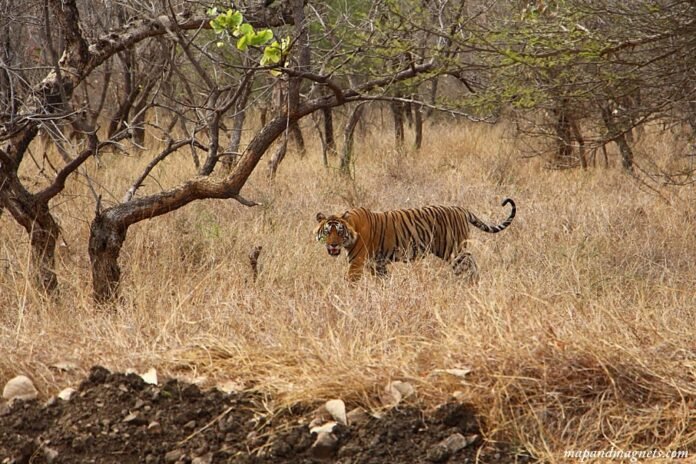Rajasthan, often synonymous with golden deserts and grand palaces, offers much more than its iconic forts and cultural heritage. The state is a haven for nature enthusiasts, housing diverse wildlife in its sprawling national parks and sanctuaries. If you’re looking for an unforgettable experience, the Rajasthan Wildlife Safari Tour is an essential adventure to explore the untamed beauty of this desert land.
A Land of Diverse Wildlife
Rajasthan’s unique geography—spanning arid deserts, lush forests, and wetland ecosystems—supports a variety of flora and fauna. The state is home to majestic tigers, elusive leopards, colorful bird species, and several endangered animals. Here’s a guide to some of the most remarkable wildlife destinations and the rare species you can encounter.
Ranthambore National Park: The Royal Bengal Tiger’s Realm
Ranthambore National Park is one of the most celebrated wildlife reserves in India, known for its thriving population of Royal Bengal Tigers. Located in the Sawai Madhopur district, the park’s rich biodiversity also includes sloth bears, jackals, and sambar deer. A morning or evening safari offers the best chance to witness tigers in their natural habitat, stalking prey or lounging by water bodies. Besides the wildlife, Ranthambore’s ancient ruins add a historical charm to your visit.
Keoladeo National Park: A Birdwatcher’s Paradise
Formerly known as Bharatpur Bird Sanctuary, Keoladeo National Park is a UNESCO World Heritage Site. This wetland reserve is an important stopover for migratory birds, including the rare Siberian crane. During the winter months, the park comes alive with the calls of thousands of waterfowl, waders, and raptors. Birdwatchers can spot painted storks, pelicans, and kingfishers, making it a must-visit destination for avian enthusiasts.
Desert National Park: Witnessing the Great Indian Bustard
Located near Jaisalmer, the Desert National Park offers a stark contrast to Rajasthan’s greener reserves. Despite its harsh environment, the park is home to unique wildlife adapted to desert conditions. The critically endangered Great Indian Bustard is the star attraction here, alongside desert foxes, chinkaras, and monitor lizards. Exploring the vast dunes and rocky terrain of this park is an adventure like no other.
Sariska Tiger Reserve: A Testament to Conservation Success
Sariska Tiger Reserve, nestled in the Aravalli Hills, is a testament to Rajasthan’s commitment to wildlife conservation. Once plagued by poaching, the park now boasts a growing population of tigers thanks to reintroduction efforts. In addition to tigers, visitors can spot leopards, hyenas, and a variety of deer species. The reserve also houses ancient temples, offering a blend of wildlife and heritage exploration.
Jawai: The Land of Leopards
For those seeking a unique wildlife experience, Jawai is the place to be. This region is famed for its harmonious coexistence of leopards and the local Rabari community. Surrounded by dramatic granite hills and serene lakes, Jawai offers an unparalleled opportunity to witness leopards in the wild. Night safaris here provide thrilling encounters under a starry sky, making it a highlight for adventurous travelers.
Flora and Fauna Beyond the Famous Parks
While Rajasthan’s major national parks are renowned, its lesser-known sanctuaries also offer exceptional wildlife encounters. The Tal Chhapar Sanctuary, for instance, is a grassland reserve famous for blackbuck antelope and harriers. Similarly, the Mount Abu Wildlife Sanctuary provides a refreshing retreat with its cool climate and sightings of Indian pangolins and jungle cats.
Eco-Tourism and Sustainable Practices
Rajasthan’s growing emphasis on eco-tourism ensures that wildlife exploration does not come at the cost of environmental degradation. Many reserves have adopted sustainable practices, including limiting safari vehicles, encouraging eco-friendly accommodations, and educating visitors about conservation. Travelers can contribute by respecting park guidelines and choosing responsible tour operators.
Planning Your Rajasthan Wildlife Safari
Embarking on a wildlife safari in Rajasthan requires careful planning to maximize your experience. Opt for guided tours with trained naturalists who can provide insights into the region’s biodiversity. Book safaris well in advance, especially during peak seasons from October to March, when wildlife sightings are more frequent. A reputable travel agency in Rajasthan can assist in curating a seamless itinerary that covers the state’s diverse offerings.
Essential Tips for Wildlife Enthusiasts
- Best Time to Visit: Winter months (October to March) offer cooler weather and better wildlife visibility.
- What to Pack: Comfortable clothing in muted colors, sturdy shoes, binoculars, and a camera for capturing memorable moments.
- Safari Etiquette: Maintain silence, respect animal habitats, and avoid littering to preserve the sanctity of these natural reserves.
- Stay Options: Choose accommodations close to the reserves for easy access to early morning safaris.
Why Rajasthan Stands Out
What sets Rajasthan apart as a wildlife destination is its seamless integration of nature, culture, and history. The sight of a tiger prowling near a centuries-old fort or a flock of migratory birds against a backdrop of golden sands is a reminder of the state’s multifaceted allure. Whether you’re a wildlife photographer, an avid birder, or a curious traveler, Rajasthan offers a once-in-a-lifetime experience.
Conclusion
Rajasthan’s wildlife sanctuaries and national parks offer a treasure trove of rare and memorable encounters. From the elusive tigers of Ranthambore to the graceful Great Indian Bustard of the Desert National Park, the state’s biodiversity is as vast as its deserts. Plan your journey today and immerse yourself in the untamed beauty of Rajasthan. Let the Rajasthan Wildlife Safari Tour be your gateway to an unforgettable adventure!



